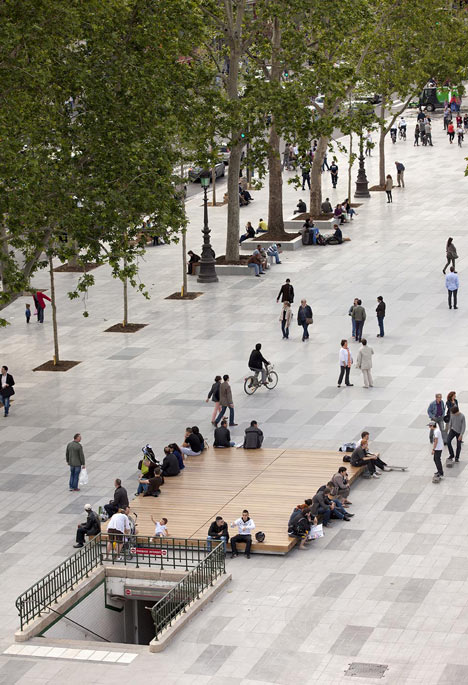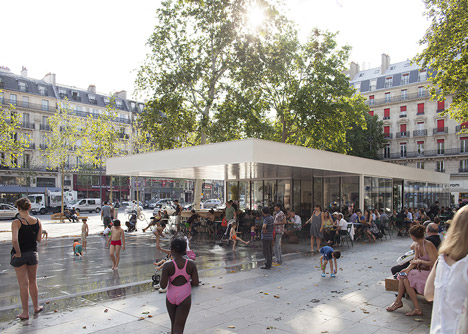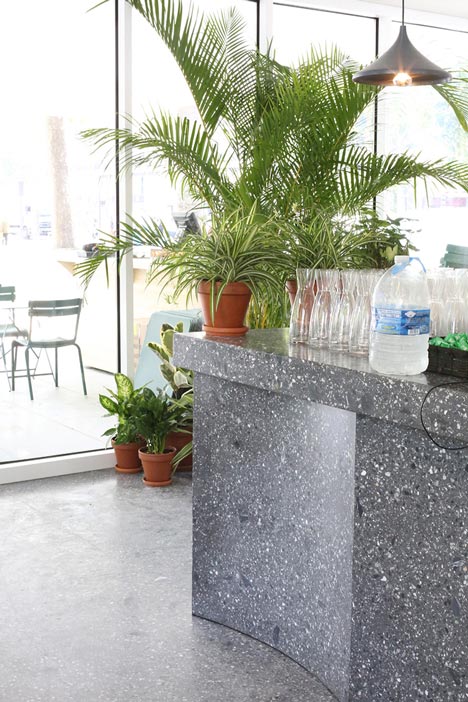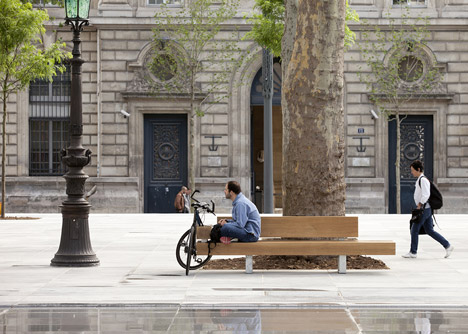TVK transforms Place de la République into Paris' largest pedestrian square
French studio TVK has overhauled the Place de la République in Paris to create an even larger pedestrian plaza that includes a new cafe pavilion, water features and over 150 trees (+ slideshow).

TVK's largest intervention was to adapt the surrounding road layout to make more pedestrian-priority areas. This increased the size of the square to 280 metres wide by 120 metres long, making it the largest pedestrian space in the city.

"The redevelopment of the Place de la République is based on the concept of an open space with multiple urban uses," said the architects.

"The elimination of the traffic circle frees the site from the dominating constraint of motor vehicle traffic. The creation of the concourse marks the return of calm in an airy, uncluttered two hectare space," they added.

The new cafe has been added to the south-west side of the square. Named Monde & Médias Pavilion, which translates as World and Media Pavilion, it was designed to host different public activities.

All four sides of the building are glazed to allow views through. A solid canopy cantilevers from one side to create a sheltered seating area and its underside is clad with reflective aluminium.

French studio NP2F Architectes designed the interior of the cafe, which features a fluted marble bar, wooden chairs and an assortment of plants.

Three different kinds of concrete slabs were used to create the surface of the square and are interspersed with plane trees, honey locust trees and lighting columns.

A circular water basin has been added around the nineteenth century statue at the centre of the square, while the a second water feature comprises a plane of water covering a small area outside the cafe.

Photography is by Clement Guillaume.
Here's a project description from the designers:
Monde & Medias Pavilion and Place de la République, Paris
TVK hand over the redevelopment of the Place de la République, inaugurated by the mayor of Paris on June 2013.
Due to its exceptional size (120m by nearly 300m), its symbolic dimension as a representative public statement and its location in the city, the Place de la République occupies a special place in the international hub that is Paris.
The redevelopment of the Place de la République is based on the concept of an open space with multiple urban uses. The elimination of the traffic circle frees the site from the dominating constraint of motor vehicle traffic. The creation of the concourse marks the return of calm in an airy, uncluttered two hectare space. The new square, now skirted by motor traffic, creates a large-scale landscape and becomes an urban resource, available and adaptable for different uses. Clear connections with the large boulevards promote a new balance centred on soft transport for pedestrians, cyclists and public transport.

The statue of Marianne, the reflective pool, the pavilion and the rows of the trees form a strong axis. This harmony is amplified by the serene balance of the mineral element and a very gentle slope of 1%. All these elements contribute to both the interpretation of unitary materials in a perennial and contemporary manner and multiple explorations (colours, water, lights) creating different urban ambiances. The Place de la République is now the largest pedestrian square in Paris.
The south-west part of the square houses a 162 m² pavilion, a unique building, glazed throughout to retain a continuous impression of this singular space. The pavilion was conceived and designed by TVK Architectes Urbanistes. It's interior layout has been designed by NP2F architectes.

The articulation of public and pedestrian areas
Abandoning the traffic circle model
The redevelopment of the Place de la République is based on a decision to create the largest possible public pedestrian area. Paris was in need of an exceptionally large and versatile public place, like an open field in the heart of the city, a feature found in many other large cities. Also, it was essential to move away from the traffic circle model.

Functional & environmental dissymmetry
Two-fold dissymmetry, both functional and environmental, is used along the long axis of the square to blend it into the general urban setting.
Motor traffic has been reorganised. It now runs along the southern edge and two smaller sides of the square only. Now that the traffic runs in both directions and the pavements have been widened, the road is much more similar to the large Parisian boulevards.
Unity and balance
The Place de la République is also open to varied groups participating in a very wide range of activities. The aim of the project was to cater for these users by changing the balance between the roadway and the concourse. The most important challenge was to reunify and harmonise the attributes of a city with those of a local neighbourhood.

The pavilion's design
In line with the principles adopted in the redevelopment of the Place de la République, the "Monde & Médias" Pavilion is a perennial building, designed to last. It is scalable and adaptable, but also is a strong presence, opening onto the square. It is the only edifice in the new square. The Pavilion is sited on the southwest part, in line with the reflective pool and the statue de la Republique. It is fully glazed so as not to obscure the view and provides a continuous vista of the square. The pavilion houses a "World & Media" themed café and its entirely modular interior can host a wide variety of festive, social and cultural events and uses in all seasons and all weathers.
The pavilion is assertively simple in design, comprising a closed volume, 9.29m by 18.20m and 3m high, and a 0.75m-thick roof with an 8.70m cantilever.

The pavilion’s envelope is entirely glazed. The visual impact of its structural assembly is minimal, so as not to perturb the prismatic appearance of the overall volume: the metallic elements are integrated to a maximum and the opening zones are concentrated to create an image of large glazed planes jointed together.
The supporting structure also participates in this self-effacement to achieve transparency: reduced to four small-diameter metallic posts at the corners, it is similar in design to the metallic elements. The roof band is composed of aluminium sheeting whose assemblage is invisible, with its horizontal and vertical aluminium rigidifying elements following the same rhythm as that of the glazed panels.
The cantilever's underside is clad with large sheets of perforated aluminium. Echoing the large symmetrical composition of the Place de la République, the space’s interior organisation is dictated by a partition dividing it lengthways into two distinct and symmetrical areas.

Composition of the area and surface
The surface
The surface consists of paving slabs of different colours and sizes. The shady areas of the square are paved mostly in darker colours, while the open areas are generally paler.
The choice of prefabricated concrete ensures good performance in all weather, offering maximum resistance to the greatest variety of uses. This material also enables the use of monochrome colours, creating continuity with the surrounding surfaces of roads and roofs.
Three types of concrete paving slabs have been used in the square, reflecting its overall layout:
- "large module" prefabricated slabs in the centre of the concourse, to give a wide perspective and cater for large-scale uses,
- "medium module" prefabricated slabs for the rest of the esplanade along the concourse,
- and lastly, "small module" prefabricated slabs (on a more ordinary scale) for the north and south pavements. The bus lane to the north of the square is made of poured concrete.

Levels
The density of the networks present under the Place de la République mean it also serves as a "roof": the site is home to five Metro lines, sewers, telecom tunnels, etc. The levels create a main movement of great simplicity, vital to the spatial comprehension of the square and an understanding of its vastness. The simple 1% incline of the central concourse reveals two wide terraces at the back of the esplanade, in keeping with the scale of the surrounding area. The terraces continue the concourse but are edged to the north with steps. Between these terraces, the ground drops consistently towards the two large palace buildings and the shared trafficked area (pedestrians, cycles, buses, taxis), providing continuity of traffic flow and excellent accessibility.

A large garden, a large concourse
The square is unified by the single grand compositional movement and the one inorganic surface treatment. This unity helps to indicate three distinct sections: the urban garden of over 2,000 m2, planted and organised into several sub-areas; the central concourse of almost 12,000 m2 and 35 metres wide with the statue de la Republique as the focal point; the continuity of all the boulevards, with the road system on three of its sides and the widened pavement (13 metres on the longer side to the south west, which is the busiest side).
The terraces on the Place de la République
At the rear end of the esplanade, two flat terraces are each marked by a single step on three of their sides, which conducive to sitting and socialising. The new tree planting establishes a specific ambiance. The terraces will be equipped with movable structures expressing day-to-day and local themes, and changing with the seasons (roundabout, toy library etc.).
The playground is now located on the east terrace.

Water
Water - in various forms and with a myriad of uses (climatic, social, recreational, aesthetic) - is a key feature of the central esplanade.
The monument basin
The statue de la Republique dominates the centre of the new pedestrian esplanade. The new base takes the form of a large circular basin, at the edge of which visitors can sit, walk, play, or examine the bas-reliefs.
During the summer months, it is filled with water, adding to the number of uses. The base also houses a new lighting system for the statue. Spotlights, sunk under the sheet of water, project moving reflections over the entire monument.
The reflecting pool
On the west concourse of the esplanade, facing the Monde & Médias Pavilion, the theme of water is repeated in a minimal, contemporary version. In summer, a fine sheet of water runs down the 1% slope, covering an area of more than 270m2 (23mx12m). Sprays are connected to this sheet of water. When switched off, they affect neither the topography nor the uses of the concourse, so are almost imperceptible.

Location: Place de la République Paris 3rd, 10th and 11th arrondissements
Client: City of Paris, highways Department (Direction de la Voierie et Déplacements)
Commissioned architects and urban planners: Trévelo & Viger-Kohler
Technical consultants: ATEC
Landscapers: AREAL + Martha Schwartz Partners
Traffic and movement consultants: CITEC
Fountain consultants: JML Consultants
Lighting design: AIK - Yann Kersale
Environmental consultants: Transsolar
Dialogue and consulting: Ville Ouverte